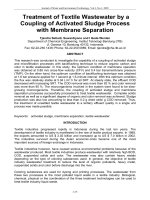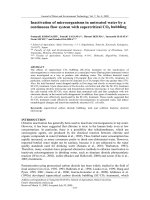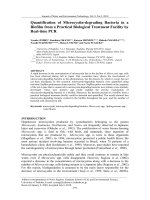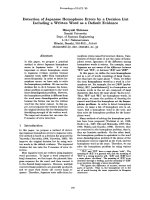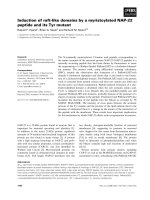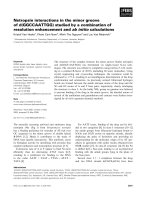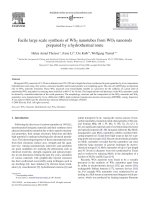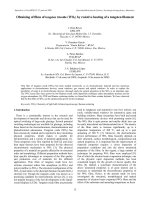Kolmogorov nWidths of Function Classes Defined by a NonDegenerate Differential Operator
Bạn đang xem bản rút gọn của tài liệu. Xem và tải ngay bản đầy đủ của tài liệu tại đây (357.86 KB, 17 trang )
Kolmogorov n-Widths of Function Classes
Defined by a Non-Degenerate Differential Operator
Patrick L. Combettes1 and Dinh D˜
ung2∗
1
Sorbonne Universit´es – UPMC Univ. Paris 06
UMR 7598, Laboratoire Jacques-Louis Lions
F-75005 Paris, France
2
Information Technology Institute
Vietnam National University
144 Xuan Thuy, Cau Giay
Hanoi, Vietnam
August 20, 2014 -- version 3.0
Abstract
[P ]
Let P (D) be the differential operator generated by a polynomial P , and let U2 be the class
of multivariate periodic functions f such that P (D)(f ) 2 1. The problem of computing the
[P ]
[P ]
asymptotic order of the Kolmogorov n-widths dn (U2 , L2 ) in the general case when U2 is
compactly embedded into L2 has been open for a long time. In the present paper, we solve it
in the case when P (D) is non-degenerate.
Keywords. Kolmogorov n-widths · Non-degenerate differential operator ·
Mathematics Subject Classifications (2010) 41A10; 41A50; 41A63
∗
Corresponding author. Email:
1
1
Introduction
The aim of the present paper is to study Kolmogorov n-widths of classes of multivariate periodic
functions given by a differential operator. In order to describe the exact setting of the problem let
us introduce some notation.
We first recall the notion of Kolmogorov n-widths [12, 19]. Let X be a normed space, let F be
a nonempty subset of X such that F = −F , and let Gn be the class of all vector subspaces of X of
dimension at most n. The Kolmogorov n-width, dn (F, X ), of F in X is given by
dn (F, X ) = inf sup inf
G∈Gn f ∈F g∈G
f −g
(1.1)
X.
This notion quantifies the error of the best approximation to the elements of F by elements in a
vector subspace in X of dimension at most n [19, 26, 27]. Recently, there has been strong interest
in applications of Kolmogorov n-width and its dual Gelfand n-widths to compressive sensing [3, 9,
10, 20], and in Kolmogorov n-width and its inverse ε-dimension of classes mixed smoothness in
high-dimensional approximations [4, 8]. ε-dimension and more general information complexity is
a tool for study of tractability of high-dimensional approximation problems; see [4, 8, 16, 17, 18]
for details and references.
We consider functions on Rd which are 2π-periodic in each variable as functions defined on
the d-dimensional torus Td = [−π, π]d . Denote by L2 (Td ) the Hilbert space of functions on Td
equipped with the standard scalar product, i.e.,
(∀f ∈ L2 (Td ))(∀g ∈ L2 (Td ))
f |g =
1
(2π)d
(1.2)
f (x)g(x)dx,
Td
and by S (Td ) the space of distributions on Td . The norm of f ∈ L2 (Td ) is f 2 =
f | f and,
d
d
i
k|·
ˆ
given k ∈ Z , the kth Fourier coefficient of f ∈ L2 (T ) is f (k) = f | e
. Every f ∈ S (Td ) can
be identified with the formal Fourier series
fˆ(k)ei
f=
k|·
(1.3)
,
k∈Zd
where the sequence (fˆ(k))k∈Zd forms a tempered sequence [23, 27]. By Parseval’s identity, L2 (Td )
is the subset of S (Td ) of all distributions f for which
|fˆ(k)|2 < +∞.
(1.4)
k∈Zd
Let α = (α1 , . . . , αd ) ∈ Nd and let f ∈ S (Td ). We set
Zd0 (α) = (k1 , . . . , kd ) ∈ Zd (∀j ∈ {1, . . . , d}) αj = 0 ⇒ kj = 0 .
(1.5)
α
As usual, we set |α| = dj=1 αj and, given z = (z1 , . . . , zd ) ∈ Cd , z α = dj=1 zj j . The αth derivative
of f ∈ S (Td ) is the distribution f (α) ∈ S (Td ) given through the identification
(ik)α fˆ(k)ei
f (α) =
k|·
(1.6)
.
k∈Zd0 (α)
2
The differential operator Dα on S (Td ) is defined by Dα : f → (−i)|α| f (α) . Now let A ⊂ Nd be a
nonempty finite set, let (cα )α∈A be nonzero real numbers, and define a polynomial by
cα xα .
P: x→
(1.7)
α∈A
The differential operator P (D) on S (Td ) generated by P is
cα Dα .
P (D) =
(1.8)
α∈A
Set
[P ]
W2
= f ∈ S (Td ) P (D)(f ) ∈ L2 (Td ) ,
[P ]
denote the seminorm of f ∈ W2
f
[P ]
W2
(1.9)
by
(1.10)
= P (D)(f ) 2 ,
and let
[P ]
U2
[P ]
= f ∈ W2
f
[P ]
W2
(1.11)
1 .
[P ]
[P ]
The problem of computing asymptotic orders of dn (U2 , L2 (Td )) in the general case when W2
is compactly embedded into L2 (Td ) has been open for a long time; see, e.g., [25, Chapter III] for
details. Our main contribution is to solve it for a non-degenerate differential operator P (D) by
establishing the asymptotic order
[P ]
dn U2 , L2 (Td )
n−r logνr n,
(1.12)
where r and ν depend only on P .
The first exact values of n-widths of univariate Sobolev classes were obtained by Kolmogorov [12] (see also [13, pp. 186–189]). The problem of computing the asymptotic order
[P ]
of dn (U2 , L2 (Td )) is directly related to hyperbolic crosses trigonometric approximations and to
n-widths of classes multivariate periodic functions with a bounded mixed smoothness. This line of
work was initiated by Babenko in [1, 2]; in particular, the asymptotic orders of n-widths in L2 (Td )
of these classes were established in [1]. Further work on asymptotic orders and hyperbolic cross
approximation can be found in [6, 7, 25] and recent developments in [14, 22, 24, 28]. In [5], the
strong asymptotic order of dn (U2A , L2 (Td )) was computed in the case when U2A is the closed unit
ball of the space W2A of functions with several bounded mixed derivatives (see Subsection 4.4 for
a precise definition). Recently, Kolmogorov n-widths in the classical isotropic Sobolev space H s of
classes of multivariate periodic functions with anisotropic smoothness have been investigated in
high-dimensional settings [4, 8], where although the dimension n of the approximating subspace
is the main parameter in the study of convergence rates with respect to n going to infinity, the
parameter d may seriously affect this rate when d is large.
3
The paper is organized as follows. In Section 2, we provide as auxiliary results Jackson-type
[P ]
and Bernstein-type inequalities for trigonometric approximations of functions from W2 . We also
[P ]
characterize the compactness of U2 in L2 (Td ) and of non-degenerateness of P (D). In Section 3,
[P ]
we present the main result of the paper, namely the asymptotic order of dn (U2 , L2 (Td )) in the case
when P (D) is non-degenerate. In Section 4, we derive norm equivalences relative to · W [P ] and,
2
[P ]
dn (U2 , L2 (Td ))
based on them, we provide examples of n-widths
operators.
2
for non-degenerate differential
Preliminaries
2.1
Notation, standing assumption, and definitions
Let Θ be an abstract set, and let Φ and Ψ be functions from Θ to R. Then we write
(∀θ ∈ Θ)
Φ(θ)
(2.1)
Ψ(θ)
if there exist constants C1 and C2 in ]0, +∞[ such that (∀θ ∈ Θ) C1 Φ(θ)
unit vectors of Rd are denoted by (uj )1 j d .
C2 Φ(θ). The
Ψ(θ)
Definition 2.1 Let A be a nonempty finite subset of Rd+ . The polyhedron spanned by A is the
convex hull conv(A) of A,
∆(A) = α ∈ A
λα λ ∈ [1, +∞[ ∩ conv(A) = {α} ,
(2.2)
and E(A) the set of vertices of ∆(A). In addition,
∀x ∈ Rd+
mA (x) = max xα
(2.3)
α∈A
and
(∀t ∈ [0, +∞[)
ΩA (t) = k ∈ Nd mA (k)
(2.4)
t .
Throughout the paper, we make the following standing assumption.
Assumption 2.2 A is a nonempty finite subset of Nd and (cα )α∈A are nonzero real numbers. We
set
cα xα ,
P: x→
M : x → max |xα |,
α∈E(A)
α∈A
and τ = inf |P (k)|.
(2.5)
k∈Zd
Moreover, for every t ∈ [0, +∞[,
K(t) = k ∈ Zd |P (k)|
t
and V (t) =
fˆ(k)ei
f ∈ S (Td ) f =
k∈K(t)
4
k|·
.
(2.6)
Remark 2.3 Suppose that t ∈ ]τ, +∞[. Then K(t) = ∅ and dimV (t) = |K(t)|, where |K(t)|
denotes the cardinality of K(t). In addition, if |K(t)| < +∞, then V (t) is the space of trigonometric
polynomials with frequencies in K(t).
Definition 2.4 The Newton diagram of P is ∆(A) and the Newton polyhedron of P is Γ(P ) =
conv(A). The intersection of Γ(P ) with a supporting hyperplane of Γ(P ) is called a face of Γ(P ).
The dimension of a face ranges from 0 to d − 1. A vertex is a 0-dimensional face. The set of
vertices of Γ(P ) is ϑ(P ) and the set of faces of Γ(P ) is Σ(P ). The differential operator P (D) is
non-degenerate if P and, for every σ ∈ Σ(P ), Pσ : Rd → R : x → α∈σ cα xα do not vanish outside
the coordinate planes of Rd , i.e.,
d
∀x ∈ R
d
⇒
xj = 0
∀σ ∈ Σ(P )
P (x)Pσ (x) = 0.
(2.7)
j=1
2.2
Trigonometric approximations
We first prove a Jackson-type inequality.
Lemma 2.5 Let t ∈ ]0, +∞[ and define the linear operator St : S (Td ) → S (Td ) by
∀f ∈ S (Td )
fˆ(k)ei
St (f ) =
k|·
(2.8)
.
k∈K(t)
[P ]
Let f ∈ W2
and
and suppose that t > τ . Then the distribution f − St (f ) represents a function in L2 (Td )
f − St (f )
t−1 f
2
[P ]
W2
(2.9)
.
Proof. Set g = f − St (f ). Then g ∈ S (Td ). On the other hand, Parseval’s identity yields
f
2
[P ]
W2
|P (k)|2 |fˆ(k)|2 .
=
(2.10)
k∈Zd
Hence,
|fˆ(k)|2
|ˆ
g (k)|2 =
k∈Zd
k∈Zd \K(t)
|P (k)|−2
sup
k∈Zd \K(t)
t−2 f
|P (k)|2 |fˆ(k)|2
k∈Zd \K(t)
2
[P ] ,
W2
(2.11)
which means that f − St (f ) represents a function in L2 (Td ) for which (2.9) holds.
5
Corollary 2.6 Let t ∈ ]τ, +∞[. Then
f −g
sup
inf
[P ]
f ∈U2
g∈V (t)
f −g∈L2 (Td )
2
t−1 .
(2.12)
Next, we prove a Bernstein-type inequality.
Lemma 2.7 Let f ∈ V (t) ∩ L2 (Td ) and let t ∈ ]τ, +∞[. Then
f
t f
[P ]
W2
(2.13)
2.
Proof. By (2.10), we have
f
2
[P ]
W2
|P (k)|2 |fˆ(k)|2
=
k∈K(t)
|fˆ(k)|2
sup |P (k)|2
k∈K(t)
t2 f
2
2,
(2.14)
k∈K(t)
which provides the announced inequality.
2.3
Compactness and non-degenerateness
We start with a characterization of the compactness of the unit ball defined in (1.11).
[P ]
Lemma 2.8 The set U2
is a compact subset of L2 (Td ) if and only if the following hold:
(i) For every t ∈ ]τ, +∞[, K(t) is finite.
(ii) τ > 0.
Proof. To prove sufficiency, suppose that (i) and (ii) hold, and fix t ∈ ]τ, +∞[. By (i), V (t) is a
set of trigonometric polynomials and, consequently, a subset of L2 (Td ). In particular, using the
notation (2.8), (∀f ∈ S (Td )) St (f ) ∈ L2 (Td ). Hence, by Lemma 2.5,
[P ]
∀f ∈ W2
f = (f − St (f )) + St (f ) ∈ L2 (Td ).
[P ]
(2.15)
[P ]
Thus, W2 ⊂ L2 (Td ). On the other hand, (2.10) implies that U2 is a closed subset of L2 (Td ).
Therefore, it is compact in L2 (Td ) if, for every ε ∈ ]0, +∞[, there exists a finite ε-net in L2 (Td ) for
[P ]
U2 or, equivalently, if the following following two conditions are satisfied:
(iii) For every ε ∈ ]0, +∞[, there exists a finite dimensional vector subspace Gε of L2 (Td ) such
that
sup
[P ]
f ∈U2
inf
g∈Gε
f −g
2
(2.16)
ε.
6
[P ]
(iv) U2
is bounded in L2 (Td ).
It follows from (2.10) that (ii)⇔(iv). On the other hand, since dim V (t) = |K(t)|, Corollary 2.6
yields (i)⇒(iii). To prove necessity, suppose that (i) does not hold. Then dim V (t˜) = |K(t˜)| = +∞
[P ]
for some t˜ ∈ ]0, +∞[. By Lemma 2.7, U = f ∈ V (t˜) ∩ L2 (Td )
f 2 1/t˜ is a subset of U2
[P ]
which is not compact in L2 (Td ). If (ii) does not hold, then U2
consequently, not compact in L2 (Td ).
∩ L2 (Td ) is unbounded and,
The following lemma characterizes the non-degenerateness of P (D).
Lemma 2.9 Then P (D) is non-degenerate if and only if
(∃ C ∈ ]0, +∞[)(∀x ∈ Rd )
C max |xα |.
|P (x)|
(2.17)
α∈ϑ(P )
Proof. As proved in [11, 15], P (D) is non-degenerate if and only if
(∃ C1 ∈ ]0, +∞[)(∀x ∈ Rd )
|P (x)|
|xα |.
C1
(2.18)
α∈ϑ(P )
Hence, since there exist constants C2 and C3 in ]0, +∞[ such that
(∀x ∈ Rd )
C2 max |xα |
α∈ϑ(P )
|xα |
C3 max |xα |,
(2.19)
α∈ϑ(P )
α∈ϑ(P )
the proof is complete.
Lemma 2.10 Let B be a nonempty finite subset of Rd+ and let t ∈ [0, +∞[. Then ΩB (t) is finite if and
only
(∀j ∈ {1, . . . , d})(∃ aj ∈ ]0, +∞[) B ∩ span(uj ) = {aj uj }.
(2.20)
Proof. If (2.20) holds, then ΩB (t) ⊂ dj=1 x ∈ Rd+ xj t1/aj and, consequently, ΩB (t)
is bounded. Conversely, if (2.20) does not hold, there exists j ∈ {1, . . . , d} such that
muj m ∈ N ⊂ ΩB (t), which shows that ΩB (t) is unbounded.
[P ]
Theorem 2.11 Suppose that P (D) is non-degenerate. Then U2
only if (2.20) is satisfied and 0 ∈ A.
is a compact subset of L2 (Td ) if and
Proof. It follows from Young’s inequality that there exists C1 ∈ ]0, +∞[ such that
(∀x ∈ Rd )
|P (x)|
C1 max |xα |.
(2.21)
α∈ϑ(P )
Hence, by Lemma 2.9, there exist C2 ∈ ]0, +∞[ such that
(∀x ∈ Rd )
C2 max |xα |
α∈ϑ(P )
|P (x)|
C1 max |xα |.
α∈ϑ(P )
7
(2.22)
[P ]
Consequently, by Lemma 2.8, U2
ΩA (t) is finite and
is a compact set in L2 (Td ) if and only if, for every t ∈ [0, +∞[,
(2.23)
inf mA (x) > 0.
x∈Nd
By Lemma 2.10, the first condition is equivalent to (2.20), and the second to 0 ∈ A.
3
Main result
The following facts will be necessary to prove our main result.
Lemma 3.1 Let B be a nonempty finite subset of Rd+ and let x ∈ Rd+ . Then mB (x) = mE(B) (x).
Proof. It is clear that mE(B) (x) mB (x). Conversely, let α ∈ B E(B). On the one hand, there
exists ρ ∈ ]1, +∞[ such that α = ρα ∈ ∆(B). One the other hand, by Carath´eodory’s theorem [21,
Theorem 17.1], α is a convex combination of points (αj )1 j d+1 in E(B), say
d+1
d+1
λj α j ,
α =
where
{λj }1
j d+1
⊂ [0, +∞[
j=1
and
λj = 1.
(3.1)
j=1
Hence, by Young’s inequality
d+1
α
α
x
d+1
α j λj
=
λ j xα
(x )
j=1
j
max xα
1 j d+1
j=1
j
mE(B) (x).
(3.2)
Corollary 3.2 Suppose that P (D) is non-degenerate. Then there exist C1 ∈ ]0, +∞[ and C2 ∈
]0, +∞[ such that
∀x ∈ Rd
C1 M (x)
|P (x)|
(3.3)
C2 M (x).
Proof. Combine (2.22), Lemma 2.9, and Lemma 3.1.
For a given finite set B ⊂ Rd+ , consider the following convex problem in Rd
d
max
x∈B ◦
(3.4)
xj ,
j=1
where
B ◦ = x ∈ Rd (∀α ∈ B) α | x
(3.5)
1
8
is the polar of B. Denote by µ(B) the (maximal) value of Problem (3.4) and by ν(B) the dimension
of its set of solutions. We put also
(3.6)
r(B) = 1/µ(B).
One can verify that
r(B) = max ρ ρ1 ∈ conv(B) ,
(3.7)
and ν(B) is the dimension of the minimal face of the polyhedron conv(B) which contains the point
r(B)1 as a relative interior point, where 1 = (1, . . . , 1) ∈ Rd . Notice also that 0 ν(B) d − 1.
Lemma 3.3 Let B meet all the axes at a point aj uj for some aj > 0. Then
(∀t ∈ [2, +∞[) |ΩB (t)|
tµ(B) logν(B) t.
(3.8)
Proof. Fix t ∈ [2, +∞[ and set ΛB (t) = x ∈ Rd+ mB (x) t . Then, as in the proof of Lemma 2.10,
one can see that ΛB (t) is a bounded subset in Rd+ . If we denote by vol ΛB (t) the volume of ΛB (t),
then it follows from [5, Theorem 1] that
volΛB (t)
tµ(B) logν(B) t.
(3.9)
Furthermore, proceeding as in the proof of [5, Theorem 2], one shows that
|ΩB (t)|
vol ΛB (t).
(3.10)
These asymptotic relations prove the lemma.
In computational mathematics, the so-called ε-dimension nε = nε (W, X) is used to quantify
the computational complexity. It is defined by
nε (W, X) := inf
n : ∃ Ln : sup inf
f ∈W g∈Ln
f −g
X
ε ,
where Ln is a linear subspace in X of dimension
n. This approximation characteristic is the
inverse of dn (W, X). In other words, the quantity nε (W, X) is the minimal number nε such that
the approximation of W by a suitably chosen approximant nε -dimensional subspace L in X gives
the approximation error ε.
Our main result can now be stated and proved.
Theorem 3.4 Suppose that P (D) is non-degenerate, that (2.20) is satisfied, and that 0 ∈ A. Then,
for n sufficiently large,
[P ]
dn U2 , L2 (Td )
n−r(ϑ(A)) logν(ϑ(A))r(ϑ(A)) n,
(3.11)
ε−1/r(ϑ(A)) | log ε|ν(ϑ(A)) .
(3.12)
or equivalently,
[P ]
nε U2 , L2 (Td )
9
Proof. Set t¯ = max{2, τ }. It follows from Corollary ?? that
(∀t ∈ [t¯, +∞[) |Ωϑ(A) (t)|
|K(t)|.
(3.13)
Since A satisfies (2.20), so does ϑ(A). Hence applying Lemma 3.3 to ϑ(A), we have
tµ logν t,
(∀t ∈ [t¯, +∞[) |K(t)|
(3.14)
where µ = µ(ϑ(A)) and ν = ν(ϑ(A)). In turn, for every m ∈ N, there exists C1 ∈ ]0, +∞[ such that
dim V (m)
C1 m1/r logν m.
(3.15)
For n ∈ N large enough, there exist m ∈ N such that
C1 m1/r logν m
n < C1 (m + 1)1/r logν (m + 1)
C2 m1/r logν m,
(3.16)
where C2 ∈ ]0, +∞[ is independent from n and m. It follows from (3.15), (3.16), and Corollary 2.6
that
[P ]
dn (U2 , L2 (Td ))
m−1
n−r logνr n.
(3.17)
The upper bound of (3.11) is proven. To establish the lower bound, let us recall from [26] that,
for every n + 1-dimensional subspace Ln+1 of X and every ρ ∈ ]0, +∞[, we have
dn (Bn+1 (ρ), X ) = ρ,
where
Bn+1 (ρ) = {f ∈ Ln+1 | f
X
ρ}.
(3.18)
Similarly to (3.15) and (3.16), for n ∈ N sufficiently large, there exists m ∈ N such that
dim V (m)
C3 m1/r logν m > n
C4 m1/r logν m,
(3.19)
where C3 ∈ ]0, +∞[ and C4 ∈ ]0, +∞[ are independent from n and m. Consider the set
U (m) = f ∈ V (m)
f
[P ]
By Lemma 2.7, U (m) ⊂ U2
[P ]
dn U2 , L2 (Td )
2
m−1 .
(3.20)
and consequently, it follows from (3.18) and (3.19) that
dn (U (m), L2 (Td ))
m−1
n−r logνr n,
(3.21)
which concludes the proof.
Remark 3.5 We have actually proven a bit more than Theorem 3.4. Namely, suppose that P (D)
[P ]
satisfies the conditions of compactness for U2 stated in Lemma 2.8 and for every n ∈ N, let m(n)
be the maximal number such that |K(m(n))| n. Then, for n sufficiently large, we have
[P ]
dn U2 , L2 (Td )
1
.
m(n)
(3.22)
10
4
Examples
First, we establish norm equivalences and, based on them, we provide some examples of
[P ]
dn (U2 , L2 (Td )) for non-degenerate and degenerate differential operators.
Theorem 4.1 Suppose that P (D) is non-degenerate and set
xα .
Q: x →
(4.1)
α∈E(A)
Then
[P ]
∀f ∈ W2
f
2
[P ]
W2
f
Dα f
2
[Q]
W2
2
2
α∈E(A)
max
Dα f
α∈E(A)
2
2.
(4.2)
Moreover, the semi-norms in (4.2) are a norm if and only if 0 ∈ A.
[P ]
Proof. Let f ∈ W2 . It is clear that
Dα f
2
2
Dα f
max
α∈E(A)
α∈E(A)
2
2.
(4.3)
Parseval’s identity and Corollary 3.2 yield
Dα f
max
2
2
α∈E(A)
|k|2α |fˆ(k)|2
max
α∈E(A)
k∈Zd
|M (k)|2 |fˆ(k)|2 .
(4.4)
k∈Zd
Let us decompose Zd into the subsets Zd (α), α ∈ E(A), such that
Zd =
Zd (α), Zd (α) ∩ Zd (α ) = ∅, α = α,
(4.5)
α∈E(A)
and
M (k) = |k α |,
k ∈ Zd (α).
(4.6)
(Such a decomposition is easily constructed). Then we have
max
α∈E(A)
Dα f
2
2
|k 2α ||fˆ(k)|2
= max
α∈E(A)
α ∈E(A) k∈Zd (α )
|k 2α | |fˆ(k)|2
α ∈E(A) k∈Zd (α )
|M (k)|2 |fˆ(k)|2 .
=
k∈Zd
11
(4.7)
Thus, we have proven the following equation
max
Dα f
α∈E(A)
2
2
|M (k)|2 |fˆ(k)|2 .
=
(4.8)
k∈Zd
Hence, by Corollary 3.2 and (2.10) we obtain
max
Dα f
2
2
f
2
[P ] .
W2
(4.9)
Dα f
2
2
f
2
[Q] .
W2
(4.10)
α∈E(A)
The relation
max
α∈E(A)
follows from the last semi-norm equivalence and the equation E(Q) = E(A). If follows from (4.2)
that the semi-norms in (4.2) are a norm if and only if 0 ∈ A.
4.1
Isotropic Sobolev classes
Let s ∈ N∗ . The isotropic Sobolev space H s is the Hilbert space of functions f ∈ L2 (Td ) equipped
with the norm · H s which is defined by
f
2
Hs
=
f
2
2
+
f (α) 22 .
(4.11)
xα ,
(4.12)
|α|=s
Consider
xα =
P: x→1+
α∈A
|α|=s
where A = 0 ∪ {α : |α| = s}. If s is even, the differential operator P (D) is non-degenerate and
consequently, by Theorem 4.1 the norm f H s is equivalent to one of the norms in (4.2) with
E(A) = 0 ∪ α = suj 1 j d and
d
xsj .
Q(x) = 1 +
(4.13)
j=1
Moreover, we have r(A) = s and ν(a) = 0, and therefore, for the unit ball U s in H s from Theorem 3.4 we again retrieve the well known result
dn U s , L2 (Td )
n−s .
(4.14)
12
4.2
Anisotropic Sobolev classes
For β = (β1 , . . . , βd ) ∈ N∗d , the anisotropic Sobolev space H β is the Hilbert space of functions
f ∈ L2 equipped with the norm f H β which is defined by
d
f
2
Hβ
= f
2
2
j)
f (βj u
+
2
2.
(4.15)
j=1
Consider
d
β
xα ,
xj j =
P: x→1+
j=1
(4.16)
α∈A
where A = {0} ∪ {α = βj uj | j = 1, . . . , d}. If the coordinates of β are even, the differential
operator P (D) is non-degenerate and consequently, by Theorem 4.1 the norm f H β is equivalent
to one of the norms in (4.2) with E(A) = A and
(4.17)
Q(x) = P (x).
We have
−1
d
r = r(A) =
(4.18)
1/βj
j=1
and ν(A) = 0, and therefore, for the unit ball U r in H β from Theorem 3.4 we again retrieve the
well-known result
n−r .
dn U β , L2 (Td )
4.3
(4.19)
Classes of functions with a bounded mixed derivative
Let α = (α1 , . . . , αd ) ∈ Nd with 0 < α1 = · · · = αν+1 < αν+2 = · · · = αd for some 0 ν d − 1.
For a set e ⊂ {1, . . . , d}, let the vector α(e) ∈ Nd be defined by α(e)j = αj if j ∈ e, and α(e)j = 0
otherwise (in particular, α(∅) = 0 and α({1, . . . , d}) = α). The space W2α is the Hilbert space of
functions f ∈ L2 equipped with the norm · W2α which is defined by
f
2
W2α
f (α(e)) 22 .
=
(4.20)
e⊂{1,...,d}
Consider
xα(e) =
P: x→
e⊂{1,...,d}
xα ,
(4.21)
α∈A
13
where A = α(e) e ⊂ {1, . . . , d} . If the coordinates of α are even, the differential operator P (D)
is non-degenerate and consequently, by Theorem 4.1 the norm · W2α is equivalent to one of the
norms in (4.2) with E(A) = A and
(4.22)
Q(x) = P (x).
We have r(A) = α1 and ν(A) = ν, and therefore, for the unit ball U2α in W2α from Theorem 3.4 we
again retrieve the result proven in [1], namely that for n sufficiently large
n−α1 logνα1 n.
dn U2α , L2 (Td )
(4.23)
In the particular case α = r1, we have
n−r log(d−1)r n.
dn U2r1 , L2 (Td )
4.4
(4.24)
Classes of functions with several bounded mixed derivatives
Suppose that (2.20) is satisfied and that 0 ∈ A. The space W2A is the Hilbert space of functions
f ∈ L2 (Td ) equipped with the norm · W A which is defined by
2
f
2
W2A
f (α) 22 .
=
(4.25)
α∈A
Notice that spaces H s , H r , and W2α are a particular cases of W2A . Now consider
xα .
P: x→
(4.26)
α∈A
If the coordinates of every α ∈ E(A) are even, the differential operator P (D) is non-degenerate
and consequently, by Theorem 4.1, the norm · W A is equivalent to one of the norms in (4.2). If
2
r = r(E(A)) and ν = ν(E(A)), for the unit ball U2A in W2A from Theorem 3.4 we again retrieve
the result proven in [5], namely that for n sufficiently large
n−r logνr n.
dn U2A , L2 (Td )
4.5
(4.27)
Classes of functions given by a differential operator
[P ]
We give two examples of space W2
Consider the following polynomials
with non-degenerate differential operator P (D) for d = 2.
P1 : x → = 8x41 − 4x31 − 3x31 x2 − 2x21 x2 − 4x1 x2 + 6x22 − 4x1 − 3x2 + 13,
(4.28)
P2 : x → =
6x61
+
x41 x22
−
6x51
−
x31 x22
+
5x42
−
14
4x32
+ 3.
We have
A1 = {(4, 0), (3, 0), (2, 1), (2, 0), (1, 1), (0, 2), (1, 0), (0, 1), (0, 0)},
E(A1 ) = {(4, 0), (0, 2), (0, 0)},
(4.29)
A2 = {(6, 0), (4, 2), (5, 0), (3, 2), (0, 4), (0, 3), (0, 0)},
E(A2 ) = {(6, 0), (4, 2), (0, 4), (0, 0)}.
It is easy to verify that for i = 1, 2, Pj (D) is non-degenerate, (2.20) holds, and 0 ∈ Ai . Moreover, r(E(A1 )) = 4/3, ν(E(A1 )) = 0 and r(E(A2 )) = 8/3, ν(E(A2 )) = 1. From Theorem 3.4 we
have
dn U [P1 ] , L2 (T2 )
n−4/3 ,
(4.30)
dn U [P2 ] , L2 (T2 )
n−8/3 log8/3 n.
(4.31)
and
Let us give an example of degenerate differential operator. For
P3 (x) = x41 − 2x31 x2 + x21 x22 + x21 + x22 + 1,
(4.32)
the differential operator P3 (D) is degenerate, although P3 (x)
1 for every x ∈ R2 , and U [P3 ] is
2
[P
]
a compact set in L2 (T ). Therefore, we cannot compute dn (U 3 , L2 (T2 )) by using Theorem 3.4.
However, by a direct computation we get |K(t)| t1/2 log t. Hence, by (3.22) we have
dn U [P3 ] , L2 (T2 )
4.6
n−2 log2 n.
(4.33)
A conjecture
[P ]
Suppose that U2
(i) For every t
is compact in L2 (Td ). In view of Lemma 2.8, this is equivalent to the conditions:
0, K(t) is finite.
(ii) τ > 0.
As mentioned in (3.22), for n ∈ N sufficiently large, if m(n) is the maximal number such that
|K(m(n))| n, then
[P ]
dn U2 , L2 (Td )
1
.
m(n)
(4.34)
[P ]
This means that the problem of computing the asymptotic order of dn (U2 , L2 (Td )) is equivalent
to the problem of computing that of |K(t)| when t → +∞. Let us formulate it as the following
conjecture.
15
Conjecture 4.2 Suppose that, for every t ∈ [0, +∞[, K(t) is finite (the condition τ > 0 is not
essential). Then there exist integers α, β, and ν such that 0 < α β 0 ν < d, and, for t large
enough,
|K(t)|
tα/β logν t.
(4.35)
In view of (3.14), we know that the conjecture is true when P satisfies conditions (2.7) and
(2.20).
Acknowledgment. Dinh Dung’s research work is funded by Vietnam National Foundation for
Science and Technology Development (NAFOSTED) under Grant No. 102.01-2014.02, and a part
of it was done when Dinh Dung was working as a research professor at and Patrick Combettes was
visiting the Vietnam Institute for Advanced Study in Mathematics (VIASM). Both authors thank
the VIASM for providing fruitful research environment and working condition.
References
[1] K. I. Babenko, Approximation of periodic functions of many variables by trigonometric polynomials, Soviet Math. Dokl. 1 (1960) 513–516.
[2] K. I. Babenko, Approximation by trigonometric polynomials in a certain class of periodic
functions of several variables, Soviet Math. Dokl. 1 (1960) 672–675.
[3] R. Baraniuk, M. Davenport, R. DeVore, and M. Wakin, A simple proof of the restricted isometry property for random matrices, Constr. Approx., 28(2008), 253–263.
[4] A. Chernov and Dinh D˜
ung, New estimates for the cardinality of high-dimensional hyperbolic
crosses and approximations of functions having mixed smoothness, Manuscript (2013).
[5] Dinh D˜
ung, The number of integral points in some sets and approximation of functions of
several variables, Mat. Zametki 36 (1984) 479–491.
[6] Dinh D˜
ung, Approximation of functions of several variables on a torus by trigonometric polynomials, Math. USSR-Sb. 59 (1988) 247–267.
[7] Dinh D˜
ung, Best multivariate approximations by trigonometric polynomials with frequencies
from hyperbolic crosses, J. Approx. Theory, 91 (1997) 205–225.
[8] Dinh D˜
ung and T. Ullrich, N -Widths and ε-dimensions for high-dimensional approximations,
Found. Comput. Math. 13 (2013), 965–1003.
[9] D. L. Donoho, Compressed sensing, IEEE Trans. Inform. Theory 52(2006), 1289–1306.
[10] S. Foucart, A. Pajor, H. Rauhut, and T. Ullrich, The Gelfand widths of lp -balls for 0 < p
J. Complexity 26(2010),629–640.
16
1,
[11] S. G. Gindikin, Energy estimates connected with Newton polyhedron, Trudy Moskov. Mat.
Obshch. 31(1974), 189–236.
¨ ber die beste Ann¨
[12] A. N. Kolmogorov, U
aherung von Funktionen einer Funktionklasse, Ann.
Math. 37(1936), 107–111.
[13] A. N. Kolmogorov. Selected papers, Mathematics and Mechanics, Volume I, Nauka, Moscow
1985 (in Russian).
[14] A. Kushpel and S. A. Tozoni, Entropy and widths of multiplier operators on two-point homogeneous spaces, Constr. Approx. 35 (2012) 137–180.
[15] V. P. Miha˘ılov, Behavior at infinity of a certain class of polynomials, Proc. Steklov Inst. Math.
91 (1967), 61–82.
[16] E. Novak and H. Wo´zniakowski, Tractability of Multivariate Problems. Vol. 1: Linear Information, EMS, Z¨
urich, 2008.
[17] E. Novak and H. Wo´zniakowski, Approximation of infinitely differentiable multivariate functions is intractable, Journal of Complexity 25(2009), 398–404.
[18] E. Novak and H. Wo´zniakowski, Optimal order of convergence and (in)tractability of multivariate approximation of smooth functions, Constr. Appr. 30(2009), 457–473.
[19] A. Pinkus, N-Widths in Approximation Theory, Springer-Verlag, 1985.
[20] A. Pinkus, Sparse representations and approximation theory, J. Approx. Theory 163 (2011)
388–412.
[21] R. T. Rockafellar, Convex Analysis, Princeton, Princeton University Press, 1970.
[22] H.-J. Schmeisser and W. Sickel, Winfried Spaces of functions of mixed smoothness and approximation from hyperbolic crosses, J. Approx. Theory, vol. 128, pp. 115–150, 2004.
[23] L. Schwartz, Th´eorie des Distributions, 2nd ed., Hermann & Cie, Paris, 1966.
[24] W. Sickel and T. Ullrich, Tensor products of Sobolev–Besov spaces and applications to approximation from the hyperbolic cross, J. Approx. Theory, vol. 161, pp. 748–786, 2009.
[25] V. Temlyakov, Approximation of Periodic Functions, Nova Science Publishers, Inc., New York,
1993.
[26] V. M. Tikhomirov, Widths of sets in function spaces and the theory of best approximations,
Uspekhi Mat. Nauk 15(1960), No.3 (93), 81–120; English translation in Russian Math. Survey 15(1960).
[27] V. M. Tikhomirov, Some Problems in Approximation Theory (in Russian), Moscow State University, 1985.
[28] H. Wang, Widths between the anisotropic spaces and the spaces of functions with mixed
smoothness, J. Approx. Theory 164 (2012) 406–430.
17
